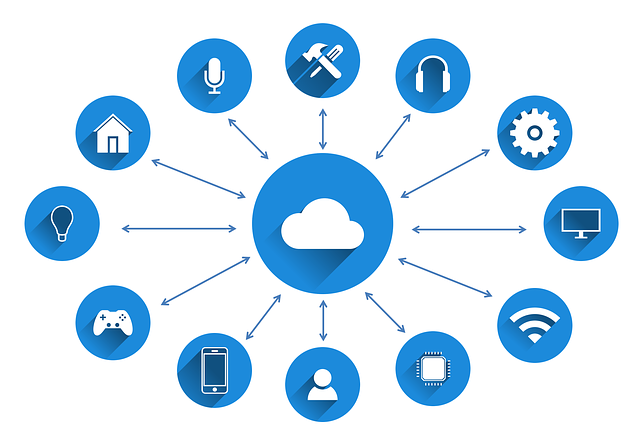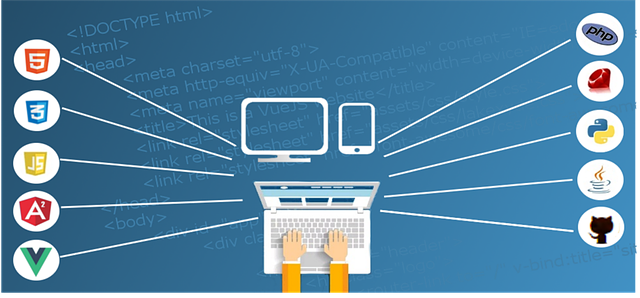What Is Cloud-based Development?
Cloud-based development is dominating the digital world. Cloud-based applications provide all kinds of businesses with more flexibility and streamline digital operations. They provide benefits such as scalability, lower equipment cost, and higher productivity. Thus, it is no surprise that the “Cloud will host 95% of computing processes and digital workload in 2021, according to Cisco.” [1]
Previously, software application development was a cumbersome process. Programmers had to sift through high amounts of data and put in long hours to deal with outdated languages. But now, Cloud development allows developers to create intricate and high-functioning mobile, web, and computer apps in no time.
So, if you’re still wondering what Cloud-based development is, this article will provide an in-depth overview of the process, where it stands compared to alternatives, and its advantages and disadvantages.

What is Cloud Development and Why Develop in the Cloud for the Cloud?
Cloud development refers to developing a software application that runs in a Cloud-based development environment and is specifically made for that environment. It means that for Cloud apps, the software is run, developed, and tested all within the Cloud environment rather than a computer or physical server.
In Cloud apps, the device does not host most of the processes; it is simply an input device. So, what are the defining characteristics of Cloud development?
- The Cloud infrastructure stores the app’s data which can be partly cached on the user’s device. Devices must meet certain criteria to run these apps.
- Cloud apps temporarily store information on a user’s device to access it while offline. When the user is online again, the app refreshes and uploads offline data in the Cloud storage.
- Users can access a Cloud app through any device. Whether you use it on a computer, smartphone, or tablet – it maintains a uniform user interface.
- Cloud apps provide users with greater flexibility. They have more control over processes like data optimization, data encryption, compression, and backup schedules.
- Cloud-based apps are easily customizable as they allow users to access third-party Cloud services through API (application programming interface) integration.
Why Develop In-Cloud?
There are many incentives for businesses to switch to Cloud development. Cloud apps offer greater efficiency because you can develop and test them in the same Cloud-based development environment.
Although Cloud development has been around for a decade, it is only recently that it gained traction due to the following reasons:
- Many businesses are making the shift to Cloud-based development environments, necessitating Cloud development.
- Cloud development offers more significant computational power than standard personal computers. Software and services like artificial intelligence and machine learning need this power to run efficiently.
- Cloud development is not as expensive as it once was. In recent years, the cost has lowered so even if individual developers need their Cloud environment, it is still feasible to pull off.
- Software as a Service (SaaS) products are Cloud-based apps. Their increasing popularity means a greater need for Cloud development.
PowerGate can help your organization make the shift to Cloud development and utilize this new technology to its fullest potential.

Types of Cloud Apps
There are multiple varieties of Cloud-based apps. Knowing which one is best for your needs can help you make the most of this service. At PowerGate, we can clarify each type so you can decide which kind of app to create.
There are three main categories of Cloud-based apps:
Software as a Service (SaaS)
Many Cloud apps fall under the SaaS category. SaaS delivers applications over the internet as a service. This means that you can access the app on the web whenever you want, without downloading software or hardware to run it.
All you need is a reliable internet connection to run SaaS applications. Thus, you can save up on expensive hardware and licenses to run these apps.
Platform as a Service (PaaS)
PaaS is another Cloud computing model. The user only needs to provide the application code, while PaaS provides the hardware and development software.
PaaS supports the complete application development lifecycle; from building, testing, deploying, to managing, and updating. Moreover, it reduces coding time since it has pre-coded application components already built into the platform like security features, directory services, workflow, etc. It allows the development team to perform new tasks without adding more people.
The government uses Cloud technology such as Cloud.gov. “Cloud.gov is a secure and compliant Platform as a Service (PaaS). Cloud.gov helps federal agencies deliver the services the public deserves in a faster, more user-centered way.” [2]
Infrastructure as a Service (IaaS)
IaaS helps companies build tailored products without having to develop everything from the ground up. It offers services such as network resources and storage on demand.
Companies only need to provide middleware and app support, while IaaS provides complex infrastructure and maintenance. Through IaaS, you can save cash on hardware costs, reduce maintenance of data centers, and gain a better understanding of your business in real-time.
Cloud-based Apps Architecture
Cloud development heavily relies on an understanding of advanced data architecture. To clarify, the architecture needs to consist of the following:
Data Organization
Efficient data organization provides greater flexibility to organizations. In turn, this flexibility improves their web performance. So, the app architecture must include guidance for Cloud servers to decouple the data to store app components either on a private or public Cloud.
Security Algorithm
Different industries have set standards on privacy and security which Cloud-based apps need to live up to. You’ll need to implement robust security practices like encryption so that your service is not vulnerable to any threats.
Scaling Opportunities
Scaling opportunities are an integral part of the architecture as well. You should ideally consider future traffic extensions and create a margin of safety for your operational channels. Additionally, it is also essential to build an operational model; these models will help the back-end components and storage server even in extreme circumstances.
Interconnected Services
The most prominent difference between web development and Cloud application design revolves around how a Cloud-based app can be thought of as a collection of interconnected services (APIs). Therefore, integration of the APIs and other components is essential in creating an all-encompassing Cloud-based application.
Communication Logic
Communication logic is essential to ensure instant communication of most of your application’s components; however, if this process is not well-engineered, the slow load speeds could compromise your overall customer experience. Two prominent strategies: single-channel stream or system grouping can be used for optimizing communication chains.

Tools to Build Cloud-based Apps
Choosing the right tools for Cloud development cannot be emphasized enough. The wrong approach can hamper your organization’s progress and lead to low customer satisfaction. Thus, it is essential to choose renowned and trusted Cloud service vendors from among the industry’s elite.
Here are a few examples:
Microsoft Azure
Microsoft Azure allows you to manage applications across numerous Clouds with your choice of frameworks and tools. You can operate in a hybrid manner – On-Premise, across Clouds, or at the edge. Furthermore, it supports all languages and frameworks, allowing you to build and deploy on your terms.
Google Cloud Platform
Google Cloud Platform is a PaaS that offers multiple services such as big data, Cloud computing, API services, storage, machine learning, security tools, and Cloud management.
Google heavily invested in a Faster Cable system which provides users speeds of 10 terabits per second. Such speeds improve system performance and increase productivity. It is also affordable, which is a great plus for startups.
Amazon Web Services (AWS)
Amazon Web Services are affordable and reliable because you only have to pay for what you use. It offers services such as database storage, compute power, Internet of Things (IoT), analytics, blockchain, machine learning, and content delivery among others. These services are flexible and integrative, allowing you to build any app of your choice. They also help your business to scale and lower technology costs.
Cloud Development vs Cloud-native Development vs Traditional Software Development – What’s the Difference and Why Does it Matter?
Cloud development refers to building software particularly designed for a Cloud environment. Everything about it, from running, testing, and development, is done within the Cloud. In contrast, traditional software is developed on a computer and run on a Cloud or physical server.
There is also an important distinction between Cloud development and Cloud-native development. In Cloud development, you write a code either in the Cloud or on a machine connected to a Cloud environment. You only need a browser and internet connection to access a Cloud-based infrastructure. On the other hand, Cloud-native development employs more of a microservices-based architecture. It is based on dynamically orchestrated containers, has high scalability, and has easier access to Cloud infrastructure.
So, to summarize the differences between all three development styles, we can think of traditional software development to comprise of virtual machines, data centers, security monitoring, waterfall development, and migrations. Cloud-based apps can be thought of as data lakes, automated security protocols, and agile development. Lastly, Cloud-native apps are server-less, data lakes, have security automation, agile development, and CI/CD pipelines.
Cloud App Development: Key Differences
If we delve into the specifics of Cloud app development, then there is no doubt this process is vastly different from traditional software development.
Cloud-based apps utilize different tools and diverse Cloud platforms such as Microsoft Azure, Amazon Web Services, Apache CloudStack, Google Cloud Platform, etc. In a Cloud-based development environment, the final product needs to be flexible and scalable. Companies prefer Cloud development because they can store as much data as they need. Hence, developers need to keep this in mind.
Users generally don’t think that Cloud-based apps have their size limitations, but they do. After all, Cloud hosting has some associated costs. Thus, developers need to prioritize data size optimization and condensed user requests.
Lastly, the Cloud environment is vast and there is no single location to store data. This problem poses a security risk, and you need to ensure users that their data will be stored safely. To do that, you need to store a codebase separately.
The Key Elements of Cloud-Native Development
Cloud-native development has certain fundamental features. Let’s see what these are.
Microservices
Microservices allow individual features of the Cloud app to be separate entities held together by the API to form an integrated, functioning app. In traditional app development, all functionality is interconnected so, any change or update in one area can impact the others and subsequently, increase the workload for developers.
Thus, microservices allow the app to be updated and extended frequently without impacting other parts of it. It is a high investment initially, but one that is worth it.
Serverless
Rather than the operations team running the server, the Cloud provider takes on this role in a serverless capacity. This shift in responsibility allows the DevOps team to focus on the code rather than operations. The result is increased efficiency, productivity, security, and reduced costs.
Containers
Cloud environment containers hold the essential services the app needs to function. They allow the Cloud app to run in virtually any Cloud environment. Containers also free up engineering resources because major Cloud platforms like Amazon Web Services, Google Cloud Platform, and Microsoft Azure provide container management services.
CI/CD
CI/CD or continuous integration and continuous delivery, help Cloud-native developers build high-quality apps with secure updates. CI/CD automates DevOps workflow by running tests as soon as code is added or modified through Cloud-native services like Jenkins. Thus, it allows for a continuous stream of updates and additions instead of having to wait long periods for new versions or updates.

The Benefits of Cloud Development
The 21st century saw an exponential increase in data use which made it nearly impossible for businesses to keep all their essential information and systems within in-house servers. Enter Cloud computing which was an answer to this pressing problem. So, what other benefits does Cloud computing offer? Let’s take a look.
Flexibility
Cloud computing allows you to focus more on customer satisfaction and reaching business goals rather than worrying about data storage and computer issues. When a Cloud platform takes over your infrastructure, you’ll have more flexibility to work on things that truly benefit your organization.
Moreover, you can update your bandwidth almost instantly rather than go through expensive IT infrastructure updates. Greater bandwidth means greater efficiency and productivity, allowing your organization to meet business demands instantaneously.
Increased Collaboration
Through a convenient and secure Cloud-based platform, your team can view and share information to work collaboratively. Collaboration isn’t impossible without it, but Cloud services enhance it further. Some Cloud services even offer social spaces that allow your employees to connect for increased engagement.
Reduced Costs
The preliminary cost of Cloud computing is intimidating for about 20% of organizations, but it’s important to think about its benefits in the long run.
Cloud services are cheap to run and allow you to access company data easily, saving money and time in projects. Another great point is that you only pay for the services you use. So, you do not need to worry about extraneous costs. All these factors lower the overall cost, making Cloud computing a great investment.
Automatic Software Updates
Cloud-based apps automatically update themselves, so you do not have to wait for software updates to be installed. These updates also save you from performing manual updates, which in turn saves money and IT staff time.
Security
Most businesses are wary of security when it comes to Cloud servers. Important information is no longer on-site, so the question of ensuring their safety arises often. But the truth is quite the contrary. Over 94% of businesses saw improved security after making the switch to the Cloud. So, how exactly does Cloud computing offer enhanced security?
All the data transmitted over networks and stored in databases is encrypted. Encryption is a robust security feature that makes the data virtually inaccessible to hackers or others with malicious intent. Cloud-based services are also readily customizable. Hence, users can set their security settings based on their requirements.
Sustainability
Cloud services have a lower carbon footprint and may help your company be more environmentally friendly. With virtual services replacing physical hardware and servers, you can have improved energy efficiency and also cut down on data-centered energy consumption.
Loss Prevention
The Cloud is a much safer option to protect your data from losses. If most of your data is stored on office computers, then any virus or hardware malfunction puts the entirety of your company’s data at risk. But with Cloud services, your data is in the Cloud and not kept in a single location. Even if one computer fails, your data is still easily accessible from any location through another computer.
Cloud Development Drawbacks
Despite its numerous advantages and conveniences, Cloud development also has some drawbacks.
Everything being online makes it vulnerable to attacks. No online system is truly immune from threats and security breaches. Hence, you must keep this as a potential risk in mind.
You will always need a reliable and steady internet connection to access Cloud services. But there will be situations such as a power outage, or a storm where your internet connection may be lost. Such problems are quite common in developing countries or remote areas, so Cloud computing may not be easily accessible for everyone.
Furthermore, whenever a technical issue arises, there’s not much you can do except wait for customer support to address it. And the support team may not be available around the clock, which can delay your work. Unlike your own IT team which could resolve problems as they arise, there is a greater dependency on an outsourced service to solve your problems.
Lastly, Cloud migration can be a cumbersome task. If companies need to shift existing applications to a Cloud environment, it takes longer than usual because of factors like slow migration of data, troubleshooting, downtime, changes in security configuration, and data sync. So, companies thinking about switching to Cloud in the middle of a project need to be aware of these challenges before committing. However, if you’re starting a new application then you will not be facing these issues.
The Bottom Line
Cloud development is the future of technology. While it may be more complicated than traditional software development, the increasing interest is fostering more awareness about Cloud technologies and expertise. So, it is no longer a futuristic idea; it is very much rooted in the present and available to everyone. With the scaling opportunities, greater accessibility, and standardization, more companies are shifting to Cloud computing now more than ever.
At PowerGate, we can help you in your transition into the future with our qualified Cloud developers, architects, and software engineers.
Frequently Asked Questions about Cloud Development
- What is meant by cloud development?
Cloud development means building a software application that is designed to run in a Cloud-based development environment and is made specifically for that environment. It allows programmers to build Cloud-based apps. Cloud apps are internet-based programs where the logic and data are processed in the Cloud rather than a physical server. For users, Cloud apps work like typical websites but the data processing is handled by the Cloud via APIs.
- What is an example of a cloud-based application?
An example of a Cloud-based app is DropBox. The user can access the app from a website to upload and view their files, but the data processing and storage are done remotely on the Cloud.
- What are cloud developers?
Cloud developers create applications that run on the Cloud. They are similar to traditional software engineers, but the difference is that their programs run on a virtual system. They also need to analyze customer needs, work on designing systems, coding, as well as debugging. Cloud developers usually need to stay on rotation so they can fix any problems to avoid customer downtime.
- What is a cloud-based program?
A Cloud-based program allows users to access Cloud-based apps on shared resources like disk storage, memory, and processing power, via the internet. These shared computing resources are maintained in remote data centers specifically designed to host different types of applications on numerous platforms.
References:
- Global Cloud Index Projects Cloud Traffic to Represent 95 Percent of Total Data Center Traffic by 2021. https://newsroom.cisco.com/press-release-content?type=webcontent&articleId=1908858
- What is Cloud.gov? Cloud.gov https://Cloud.gov

